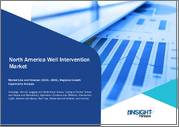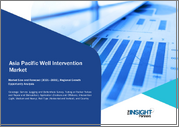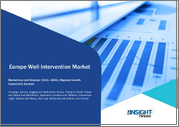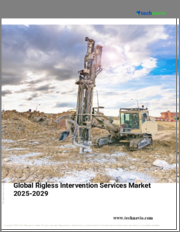
|
시장보고서
상품코드
1700122
세계의 리그리스 인터벤션 서비스 시장 : 유정 유형, 서비스 유형, 인터벤션 방법, 용도, 최종 사용자, 지역별 분석 및 예측(-2032년)Rigless Intervention Services Market Forecasts to 2032 - Global Analysis By Well Type (Vertical Wells, Horizontal Wells and Other Well Types), Service Type, Intervention Method, Application, End User and By Geography |
||||||
Stratistics MRC에 따르면 세계의 리그리스 인터벤션 서비스 시장은 2025년에 139억 2,000만 달러를 차지하고, 예측 기간 동안 CAGR은 9.2%를 나타내 2032년에는 283억 7,000만 달러에 이를 것으로 전망됩니다.
리그리스 인터벤션 서비스란, 굴삭 리그를 사용하지 않고 실시되는 오프쇼어 석유 및 가스 유정에의 개입을 가리킵니다. 야라인 유니트, 코일드 튜빙, 유압 워크오버 시스템 등의 특수 기기를 사용해, 특히 얕은 물이나 해저의 유정을 대상으로, 종래의 리그를 사용한 개입 공사를 대신하는 보다 효율적이고 비용 효율적인 방법을 제공합니다.
국제 에너지 포럼에 따르면 비용 인플레이션과 수요 증가로 인해 충분한 공급을 보장하기 위해서는 2030년까지 석유 및 가스 업스트림 자본 지출을 연간 약 22% 증가시켜야 합니다.
유정 정비 수요 증가
석유 및 가스정도가 성숙함에 따라 청소, 수리, 생산 최적화 등의 개입이 필수적입니다. 에 중점을 두고 있기 때문에 리그리스 솔루션 수요가 높아지고 있어 석유 및 가스 업계의 유지관리 전략에는 빠뜨릴 수 없는 것이 되고 있습니다.
심해 유정에의 적용은 한정적
RIS는 복잡하고 고압적인 환경으로 인해 심해 광장에 대한 적용이 제한되어 있습니다. 효과적인 유정관리, 유지보수 및 수리를 위해서는 보다 견고한 장비 기반 솔루션이 필요합니다.
해외 및 하위 바다 활동 확대
해안과 해저의 유정은 기존의 드릴링 리그로 접근하기 어려우며 비싸기 때문에 코일드 튜빙, 와이어 라인, 유압식 워크오버 시스템 등의 리그리스 기술에 대한 수요가 높아지고 있습니다. 이비스는 최소한의 다운타임으로 신속한 개입을 가능하게 하여 운용 비용을 삭감합니다.
신뢰성 문제
리그리스 인터벤션 서비스의 신뢰성 문제는 장비의 복잡성, 심해 광정 및 고압 광정과 같은 엄격한 작업 환경으로 인해 발생합니다., 생산 가동 중단으로 이어질 수 있습니다. 이러한 신뢰성에 대한 우려는 운영자의 신뢰를 낮추고 특히 위험이 큰 작업에서 RIS 채용을 제한함으로써 시장 성장을 방해합니다.
COVID-19의 영향 :
COVID-19의 대유행은 세계 공급망의 혼란, 노동력 부족, 해외 조업의 제한으로 리그리스 인터벤션 서비스 시장에 큰 영향을 주었습니다. 코르를 도입했기 때문에 시장은 회복력을 나타내, 조업의 계속이 가능하게 되었습니다.원유 가격이 회복됨에 따라, RIS와 같은 비용 효율적인 솔루션에 수요가 높아져, 신규 굴착보다 기존 유정의 유지관리에 중점이 있게 되어, 유통 후 시장 회복의 원동력이 되었습니다.
예측 기간 동안 온쇼어 부문이 최대가 될 전망
예측 기간 동안 온쇼어 부문이 가장 큰 시장 점유율을 차지할 것으로 예상됩니다. 전체 드릴링 리그를 필요로 하지 않고 유정의 클린아웃, 유압 워크오버, 생산 최적화 등의 서비스를 제공합니다.
예측 기간 동안 석유 및 가스 회사 부문이 가장 높은 CAGR이 예상됩니다.
예측 기간 동안 석유 및 가스 회사 부문이 가장 높은 성장률을 보일 것으로 예상됩니다. 비용효율이 높고 다운타임을 최소화하여 신속한 개입을 가능하게 함으로써 업무효율을 높입니다.
최대 점유율을 차지하는 지역 :
예측 기간 동안 아시아태평양은 특히 중국, 인도, 동남아시아와 같은 국가에서 해외 석유 및 가스 활동 증가로 최대 시장 점유율을 차지할 것으로 예상됩니다. 이 지역의 유전은 노후화되고 있으며 비용 효율적인 유지 보수 솔루션의 필요성이 RIS 수요를 촉진하고 있습니다. 리그리스 장비의 기술적 진보는 환경과 안전에 대한 관심 증가와 함께 시장 채택을 더욱 강화하고 있습니다. 게다가 이 지역에서는 신규 굴착보다 기존 유정의 확장으로 이동하고 있기 때문에 RIS에 대한 의존도가 높아지고 있으며, 이 지역의 에너지 부문에 있어서 중요한 요소가 되고 있습니다.
CAGR이 가장 높은 지역 :
예측 기간 동안 북미는 특히 미국과 캐나다에 성숙한 유전이 있기 때문에 가장 높은 CAGR을 나타낼 것으로 예상됩니다. 신규 유정 굴착보다 기존 유정의 유지·강화에 중점을 두는 경향이 강해짐에 따라 RIS는 비용 효율적인 솔루션을 제공합니다. 기술 진보와 운영 효율성의 필요성은 시장 성장의 원동력이되었습니다. 또, 이 지역은 석유 및 가스 산업의 인프라가 충실하고 있어, 리그리스 인터벤션 기술의 보급을 지지하고 있습니다.
무료 사용자 지정 오퍼링 :
이 보고서를 구독하는 고객은 다음 무료 맞춤설정 옵션 중 하나를 사용할 수 있습니다.
- 기업 프로파일
- 추가 시장 기업의 종합적 프로파일링(3개사까지)
- 주요 기업의 SWOT 분석(3개사까지)
- 지역 세분화
- 고객의 관심에 응한 주요국 시장 추계·예측·CAGR(주 : 타당성 확인에 따름)
- 경쟁 벤치마킹
- 제품 포트폴리오, 지리적 존재, 전략적 제휴에 기반한 주요 기업 벤치마킹
목차
제1장 주요 요약
제2장 서문
- 개요
- 이해관계자
- 조사 범위
- 조사 방법
- 데이터 마이닝
- 데이터 분석
- 데이터 검증
- 조사 접근
- 조사 자료
- 1차 조사 자료
- 2차 조사 정보원
- 전제조건
제3장 시장 동향 분석
- 성장 촉진요인
- 성장 억제요인
- 기회
- 위협
- 용도 분석
- 최종 사용자 분석
- 신흥 시장
- COVID-19의 영향
제4장 Porter's Five Forces 분석
- 공급기업의 협상력
- 구매자의 협상력
- 대체품의 위협
- 신규 참가업체의 위협
- 경쟁 기업간 경쟁 관계
제5장 세계의 리그리스 인터벤션 서비스 시장 : 유정 유형별
- 수직 유정
- 수평 유정
- 기타 유정 유형
제6장 세계의 리그리스 인터벤션 서비스 시장 : 서비스 유형별
- 코일 튜브 서비스
- 펌핑 및 자극 서비스
- 유선 서비스
- 유압 작업 서비스
- 낚시 서비스
- 기타 서비스 유형
제7장 세계의 리그리스 인터벤션 서비스 시장 : 인터벤션 방법별
- 라이트 웰 인터벤션
- 중간 유정 인터벤션
- 무거운 유정 인터벤션
제8장 세계의 리그리스 인터벤션 서비스 시장 : 용도별
- 온쇼어
- 오프쇼어
- 얕은 물
- 심해
- 초심해
제9장 세계의 리그리스 인터벤션 서비스 시장 : 최종 사용자별
- 석유 및 가스회사
- 유전 서비스 제공업체
- 정부 및 규제기관
- 기타 최종 사용자
제10장 세계의 리그리스 인터벤션 서비스 시장 : 지역별
- 북미
- 미국
- 캐나다
- 멕시코
- 유럽
- 독일
- 영국
- 이탈리아
- 프랑스
- 스페인
- 기타 유럽
- 아시아태평양
- 일본
- 중국
- 인도
- 호주
- 뉴질랜드
- 한국
- 기타 아시아태평양
- 남미
- 아르헨티나
- 브라질
- 칠레
- 기타 남미
- 중동 및 아프리카
- 사우디아라비아
- 아랍에미리트(UAE)
- 카타르
- 남아프리카
- 기타 중동 및 아프리카
제11장 주요 발전
- 계약, 파트너십, 협업, 합작투자
- 인수와 합병
- 신제품 발매
- 사업 확대
- 기타 주요 전략
제12장 기업 프로파일링
- Schlumberger Ltd.
- Halliburton Company
- Baker Hughes Company
- Expro Group Holdings NV
- Gulf Intervention Services DMCC
- Aker Solutions ASA
- Helix Energy Solutions Group Inc.
- Acteon Group Ltd.
- Oceaneering International Inc.
- EFC Group Ltd.
- Weatherford International Plc
- Odfjell Technology Ltd.
- Sapura Energy Bhd
- Abu Dhabi National Oil Co.
- Vietnam Oil and Gas Group
- Qatar Navigation QPSC
- Hunting Plc
- NOV Inc.
- Destini Bhd
- Attollo Limited
According to Stratistics MRC, the Global Rigless Intervention Services Market is accounted for $13.92 billion in 2025 and is expected to reach $28.37 billion by 2032 growing at a CAGR of 9.2% during the forecast period. Rigless intervention services refer to offshore oil and gas well interventions performed without the use of a drilling rig. These services are designed to maintain, repair, or enhance the performance of wells with minimal downtime and cost. They use specialized equipment like wireline units, coiled tubing, and hydraulic workover systems, offering a more efficient and cost-effective alternative to traditional rig-based interventions, especially for shallow and subsea wells.
According to the International Energy Forum, yearly upstream oil and gas capital spending will need to increase by around 22% by 2030 to guarantee enough supplies because of cost inflation and rising demand.
Market Dynamics:
Driver:
Increasing demand for well maintenance
As oil and gas wells mature, the need for interventions such as cleanouts, repairs, and production optimization become essential. RIS offers a viable alternative to traditional rig-based services, reducing downtime and operational costs. With a focus on maintaining and prolonging the life of existing wells, particularly in mature fields, the demand for rigless solutions grows, making them an essential part of the oil and gas industry's maintenance strategy. As the focus shifts to optimizing existing wells, RIS has become essential for continued operations and profitability.
Restraint:
Limited application for deepwater wells
RIS face limited application in deepwater wells due to the complex and high-pressure environments involved. Deepwater wells require specialized equipment and larger, more intricate interventions that cannot be efficiently managed with rigless technologies. The depth and pressure conditions demand more robust, rig-based solutions for effective well control, maintenance, and repairs. This limitation hampers market growth by reducing the scope of RIS in deepwater exploration, which is a key area of oil and gas production.
Opportunity:
Growing offshore and subsea activities
Offshore and subsea wells are often challenging and expensive to access with traditional drilling rigs, leading to a higher demand for rigless technologies like coiled tubing, wireline, and hydraulic workover systems. These services allow for quick interventions with minimal downtime, reducing operational costs. As the oil and gas industry continues to expand in deepwater and remote offshore fields, the reliance on RIS grows, boosting market demand and driving innovation in intervention technologies.
Threat:
Reliability issues
Reliability issues in rigless intervention services arise due to the complexity of the equipment and the challenging operating environments, such as deepwater or high-pressure wells. Inaccurate data, equipment malfunction, or failure during operations can lead to costly delays, safety risks, and production downtime. These reliability concerns hamper market growth by reducing operator confidence and limiting the adoption of RIS, particularly in high-stakes operations.
Covid-19 Impact:
The covid-19 pandemic significantly impacted the rigless intervention services market due to disruptions in global supply chains, workforce shortages, and restrictions on offshore operations. Reduced oil prices led to decreased exploration and production activities, affecting demand for RIS. However, the market showed resilience as companies adapted to remote working and implemented health protocols, enabling continued operations. As oil prices recovered, the demand for cost-effective solutions like RIS grew, with a focus on maintenance of existing wells rather than new drilling, driving the market's recovery post-pandemic.
The onshore segment is expected to be the largest during the forecast period
The onshore segment is expected to account for the largest market share during the forecast period. In onshore applications, RIS are increasingly used to maintain and enhance the productivity of aging oil and gas wells. RIS offers a cost-effective alternative to traditional rig-based interventions, providing services such as wellbore cleanouts, hydraulic workovers, and production optimization without the need for a full drilling rig. Rigless interventions can extend the life of wells, improve recovery rates, and reduce downtime, making them a preferred solution for onshore oil and gas operations.
The oil & gas companies segment is expected to have the highest CAGR during the forecast period
Over the forecast period, the oil & gas companies segment is predicted to witness the highest growth rate. Oil and gas companies utilize RIS to perform well maintenance, repair, and optimization operations without the need for traditional drilling rigs. This application is cost-effective and enhances operational efficiency by enabling quick interventions with minimal downtime. By using RIS, companies can extend the lifespan of wells, reduce operational costs, and maintain consistent production levels.
Region with largest share:
During the forecast period, the Asia Pacific region is expected to hold the largest market share due to increasing offshore oil and gas activities, especially in countries like China, India, and Southeast Asia. The region's aging oil fields and the need for cost-effective maintenance solutions drive demand for RIS. Technological advancements in rigless equipment, along with growing environmental and safety concerns, further boost market adoption. Moreover, the region's shift towards enhancing existing wells rather than new drilling has led to greater reliance on RIS, making it a key component in the region's energy sector.
Region with highest CAGR:
Over the forecast period, the North America region is anticipated to exhibit the highest CAGR due to the region's mature oil fields, especially in the U.S. and Canada. With the increasing focus on maintaining and enhancing existing wells rather than drilling new ones, RIS offer a cost-effective solution. Technological advancements and the need for operational efficiency drive market growth. The region also benefits from a strong oil and gas industry infrastructure, which supports the widespread adoption of rigless intervention techniques.
Key players in the market
Some of the key players in Rigless Intervention Services Market include Schlumberger Ltd., Halliburton Company, Baker Hughes Company, Expro Group Holdings N.V., Gulf Intervention Services DMCC, Aker Solutions ASA, Helix Energy Solutions Group Inc., Acteon Group Ltd., Oceaneering International Inc., EFC Group Ltd., Weatherford International Plc, Odfjell Technology Ltd., Sapura Energy Bhd, Abu Dhabi National Oil Co., Vietnam Oil and Gas Group, Qatar Navigation QPSC, Hunting Plc, NOV Inc., Destini Bhd and Attollo Limited.
Key Developments:
In March 2013, EFC Group developed and delivered innovative Rigless Intervention System, known as the Mastiff RIS, to Baker Hughes. Designed for wellbore tubular extraction during well abandonment and conductor pre-installation, it provides an alternative to traditional rig-based operations, reducing costs and improving safety.
Well Types Covered:
- Vertical Wells
- Horizontal Wells
- Other Well Types
Service Types Covered:
- Coiled Tubing Services
- Pumping & Stimulation Services
- Wireline Services
- Hydraulic Workover Services
- Fishing Services
- Other Service Types
Intervention Methods Covered:
- Light Well Intervention (LWI)
- Medium Well Intervention
- Heavy Well Intervention
Applications Covered:
- Onshore
- Offshore
End Users Covered:
- Oil & Gas Companies
- Oilfield Service Providers
- Government & Regulatory Bodies
- Other End Users
Regions Covered:
- North America
- US
- Canada
- Mexico
- Europe
- Germany
- UK
- Italy
- France
- Spain
- Rest of Europe
- Asia Pacific
- Japan
- China
- India
- Australia
- New Zealand
- South Korea
- Rest of Asia Pacific
- South America
- Argentina
- Brazil
- Chile
- Rest of South America
- Middle East & Africa
- Saudi Arabia
- UAE
- Qatar
- South Africa
- Rest of Middle East & Africa
What our report offers:
- Market share assessments for the regional and country-level segments
- Strategic recommendations for the new entrants
- Covers Market data for the years 2024, 2025, 2026, 2028, and 2032
- Market Trends (Drivers, Constraints, Opportunities, Threats, Challenges, Investment Opportunities, and recommendations)
- Strategic recommendations in key business segments based on the market estimations
- Competitive landscaping mapping the key common trends
- Company profiling with detailed strategies, financials, and recent developments
- Supply chain trends mapping the latest technological advancements
Free Customization Offerings:
All the customers of this report will be entitled to receive one of the following free customization options:
- Company Profiling
- Comprehensive profiling of additional market players (up to 3)
- SWOT Analysis of key players (up to 3)
- Regional Segmentation
- Market estimations, Forecasts and CAGR of any prominent country as per the client's interest (Note: Depends on feasibility check)
- Competitive Benchmarking
- Benchmarking of key players based on product portfolio, geographical presence, and strategic alliances
Table of Contents
1 Executive Summary
2 Preface
- 2.1 Abstract
- 2.2 Stake Holders
- 2.3 Research Scope
- 2.4 Research Methodology
- 2.4.1 Data Mining
- 2.4.2 Data Analysis
- 2.4.3 Data Validation
- 2.4.4 Research Approach
- 2.5 Research Sources
- 2.5.1 Primary Research Sources
- 2.5.2 Secondary Research Sources
- 2.5.3 Assumptions
3 Market Trend Analysis
- 3.1 Introduction
- 3.2 Drivers
- 3.3 Restraints
- 3.4 Opportunities
- 3.5 Threats
- 3.6 Application Analysis
- 3.7 End User Analysis
- 3.8 Emerging Markets
- 3.9 Impact of Covid-19
4 Porters Five Force Analysis
- 4.1 Bargaining power of suppliers
- 4.2 Bargaining power of buyers
- 4.3 Threat of substitutes
- 4.4 Threat of new entrants
- 4.5 Competitive rivalry
5 Global Rigless Intervention Services Market, By Well Type
- 5.1 Introduction
- 5.2 Vertical Wells
- 5.3 Horizontal Wells
- 5.4 Other Well Types
6 Global Rigless Intervention Services Market, By Service Type
- 6.1 Introduction
- 6.2 Coiled Tubing Services
- 6.3 Pumping & Stimulation Services
- 6.4 Wireline Services
- 6.5 Hydraulic Workover Services
- 6.6 Fishing Services
- 6.7 Other Service Types
7 Global Rigless Intervention Services Market, By Intervention Method
- 7.1 Introduction
- 7.2 Light Well Intervention (LWI)
- 7.3 Medium Well Intervention
- 7.4 Heavy Well Intervention
8 Global Rigless Intervention Services Market, By Application
- 8.1 Introduction
- 8.2 Onshore
- 8.3 Offshore
- 8.3.1 Shallow Water
- 8.3.2 Deepwater
- 8.3.3 Ultra-Deepwater
9 Global Rigless Intervention Services Market, By End User
- 9.1 Introduction
- 9.2 Oil & Gas Companies
- 9.3 Oilfield Service Providers
- 9.4 Government & Regulatory Bodies
- 9.5 Other End Users
10 Global Rigless Intervention Services Market, By Geography
- 10.1 Introduction
- 10.2 North America
- 10.2.1 US
- 10.2.2 Canada
- 10.2.3 Mexico
- 10.3 Europe
- 10.3.1 Germany
- 10.3.2 UK
- 10.3.3 Italy
- 10.3.4 France
- 10.3.5 Spain
- 10.3.10 Rest of Europe
- 10.4 Asia Pacific
- 10.4.1 Japan
- 10.4.2 China
- 10.4.3 India
- 10.4.4 Australia
- 10.4.5 New Zealand
- 10.4.10 South Korea
- 10.4.7 Rest of Asia Pacific
- 10.5 South America
- 10.5.1 Argentina
- 10.5.2 Brazil
- 10.5.3 Chile
- 10.5.4 Rest of South America
- 10.6 Middle East & Africa
- 10.6.1 Saudi Arabia
- 10.6.2 UAE
- 10.6.3 Qatar
- 10.6.4 South Africa
- 10.6.5 Rest of Middle East & Africa
11 Key Developments
- 11.1 Agreements, Partnerships, Collaborations and Joint Ventures
- 11.2 Acquisitions & Mergers
- 11.3 New Product Launch
- 11.4 Expansions
- 11.5 Other Key Strategies
12 Company Profiling
- 12.1 Schlumberger Ltd.
- 12.2 Halliburton Company
- 12.3 Baker Hughes Company
- 12.4 Expro Group Holdings N.V.
- 12.5 Gulf Intervention Services DMCC
- 12.6 Aker Solutions ASA
- 12.7 Helix Energy Solutions Group Inc.
- 12.8 Acteon Group Ltd.
- 12.9 Oceaneering International Inc.
- 12.10 EFC Group Ltd.
- 12.11 Weatherford International Plc
- 12.12 Odfjell Technology Ltd.
- 12.13 Sapura Energy Bhd
- 12.14 Abu Dhabi National Oil Co.
- 12.15 Vietnam Oil and Gas Group
- 12.16 Qatar Navigation QPSC
- 12.17 Hunting Plc
- 12.18 NOV Inc.
- 12.19 Destini Bhd
- 12.20 Attollo Limited




















